 La Sierra Madre: The Mother Range. It’s fitting that Mexico would give all three of its major mountain ranges the same name, differentiated only by their location—Sierra Madre Occidental, Sierra Madre Oriental, Sierra Madre del Sur. After all, this is a land where devotion to the ideal of the maternal is endemic, where shrines to the Virgin are rarely a stone’s throw apart, and where madres, abuelas, and tias have traditionally ground the corn, dried the carne, and pounded the chile that comprises the life-sustaining triumvirate of Mexican cuisine.
La Sierra Madre: The Mother Range. It’s fitting that Mexico would give all three of its major mountain ranges the same name, differentiated only by their location—Sierra Madre Occidental, Sierra Madre Oriental, Sierra Madre del Sur. After all, this is a land where devotion to the ideal of the maternal is endemic, where shrines to the Virgin are rarely a stone’s throw apart, and where madres, abuelas, and tias have traditionally ground the corn, dried the carne, and pounded the chile that comprises the life-sustaining triumvirate of Mexican cuisine.
 Click to enlargeThe sierras give life to the country too. Peaks ten thousand feet tall scrape rain from clouds spawned in two oceans and two seas, sending it cascading through pine and fir forests where thick-billed parrots screech at stooping goshawks, down through oak woodlands where moonlight fires the eyes of jaguars and ocelots, and out to water the valleys and plains where corn grows, cows graze, and chiles ripen in the sun.
Click to enlargeThe sierras give life to the country too. Peaks ten thousand feet tall scrape rain from clouds spawned in two oceans and two seas, sending it cascading through pine and fir forests where thick-billed parrots screech at stooping goshawks, down through oak woodlands where moonlight fires the eyes of jaguars and ocelots, and out to water the valleys and plains where corn grows, cows graze, and chiles ripen in the sun.
What better goal for a scientific expedition, then, than to explore and celebrate the life in its myriad forms that springs from the Mother Range? That’s the idea behind MABA—the Madrean Archipelago Biodiversity Assessment.
 Click here to download the story in our Terra magazine format, with 16 pages of images, interactive links, and multimedia, or follow the link below to read a simpler version on the website. You can also order a print copy from MagCloud, our HP print partner, here.
Click here to download the story in our Terra magazine format, with 16 pages of images, interactive links, and multimedia, or follow the link below to read a simpler version on the website. You can also order a print copy from MagCloud, our HP print partner, here.
MABA is the brainchild of the Tucson-based Sky Island Alliance, one of the most effective grass-roots conservation organizations in the U.S. The continuing mission of the MABA project is to catalog biodiversity in the Sky Island region of northwestern Mexico and the southwestern United States, where the Madrean Archipelago rises up in isolated “islands” from the surrounding grasslands and deserts and provides a refuge for plant and animal species that couldn’t exist here otherwise. Each MABA expedition brings together scientists from multiple disciplines and countries, and focuses on a specific area, generally around a stationary base camp where cataloging specimens is easier.
At the end of July, Roseann and I accompanied the latest MABA expedition into the Sierra Madre Occidental, to a remote property in the state of Sonora, Mexico, called El Rincón de Guadalupe. The property is in a wild region accessible by four-wheel-drive roads, east of Hermosillo.
Our function on the team was to initiate a survey of the large mammal residents of the area, by recording animal tracks and sign (such as scat and scrapes) as well as setting up motion-triggered infra-red trail cameras. Because of our background in expeditions and overlanding, we were also to provide 4WD expertise and backup for the 15 vehicles along on the trip. Chris Marzonie, longtime friend, professional photographer, and overlander, also came along to provide another pair of sharp eyes for tracking, and a higher level of 4WD expertise than our own (this was Chris’s second MABA trip).
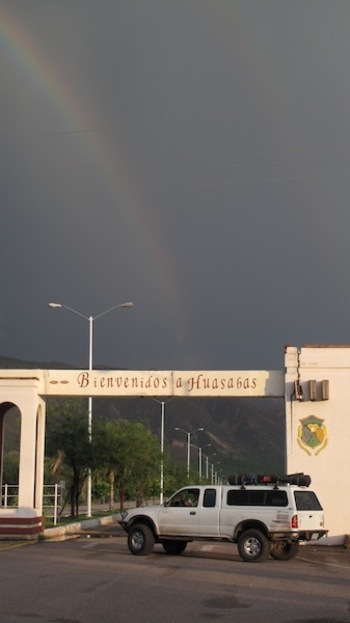 Chris Marzonie's Tacoma with rainbow at Huasabas.After the usual amusing border chaos at Douglas, Arizona, and Agua Prieta, Sonora, the convoy turned south on Mexico 17, then east at Moctezuma. The road began twisting and climbing through the foothills, and everywhere we saw evidence of the massive freeze that hit the entire region in January (it dropped to 14ºF at our house). The tree morning glories seemed especially affected, and appeared to have lost 80 to 90 percent of their mass—yet new growth was already showing between the skeletonized frozen limbs. Agaves, too, had turned brown and crisp. But the dead matter showed up as discreet tan blotches amid the intense green growth spawned by the summer rains.
Chris Marzonie's Tacoma with rainbow at Huasabas.After the usual amusing border chaos at Douglas, Arizona, and Agua Prieta, Sonora, the convoy turned south on Mexico 17, then east at Moctezuma. The road began twisting and climbing through the foothills, and everywhere we saw evidence of the massive freeze that hit the entire region in January (it dropped to 14ºF at our house). The tree morning glories seemed especially affected, and appeared to have lost 80 to 90 percent of their mass—yet new growth was already showing between the skeletonized frozen limbs. Agaves, too, had turned brown and crisp. But the dead matter showed up as discreet tan blotches amid the intense green growth spawned by the summer rains.
At Huásabas we turned south to spend the night at a hotel in Granados, where a crew from CONANP, the Mexican corollary to the U.S. Forest Service, cooked us up a satisfying barbacoa as a light drizzle fell—presaging more rain, I suspected.
The following morning our group was granted a transcendent experience, when we stopped to visit the plain but graceful 18th-century mission church in Granados. I had noticed that one of the herpetologists on the trip, a young man named Robert Villa, of Tucson, had brought along a battered violin case. Now, with some trepidation, I watched him carry it into the church, where he brought out an instrument that glowed with the same patina as the ancient wooden pews and altar. Standing in the aisle near the front, Robert produced the discordant notes that always accompany the tuning of an instrument. And then, as I and the rest of the group—along with a quickly growing number of the town’s residents—stood, entranced, the perfect strains of a Bach concerto rose through the sunlight slanting in through the windows, and filled the far corners of the mission. The already towering arch of the nave seemed to soar even higher, the air brightened and shimmered in tune with the movement of Robert’s bow. By the time the last notes faded away, more than one of us were blinking back tears.
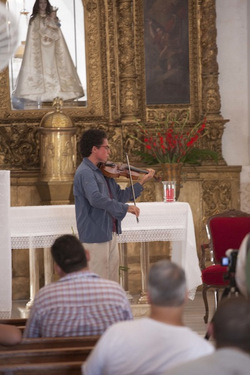 Robert Villa playing at Bacadéhuachi.Later that morning, in the more elegant mission at Bacadéhuachi, where we were to turn off the pavement, Robert repeated his performance with an anonymous medieval Sephardic piece every bit as eloquent as the Bach.
Robert Villa playing at Bacadéhuachi.Later that morning, in the more elegant mission at Bacadéhuachi, where we were to turn off the pavement, Robert repeated his performance with an anonymous medieval Sephardic piece every bit as eloquent as the Bach.
[Click here to hear Robert play. MP3 recording courtesy Dale Turner.]
Did I predict rain? At about 2:00 in the afternoon I stood ankle deep in a muddy torrent, soaked to the skin, marshaling vehicle after vehicle up a sluice whose proper line changed with the passage of each set of scrabbling tires, as cantaloupe-sized rocks washed down the gully in the runoff. Rain jacket? Of course I had a rain jacket—a hastily grabbed years-old equipment-review subject, the cut-rate waterproofing of which had apparently simply evaporated.
Meanwhile, Chris was far down the mountain, tending to a participant’s well-used Tacoma with a clutch that turned out to be, happily, only temporarily fried by enthusiastic use. Fortunately Chris’s and our two-meter radios were connecting well despite the folded terrain, so we knew who was where.
By the evening, all the vehicles had made it to Rincón de Guadalupe, with Chris bringing up the tail gunner position, and we settled in to the bunkhouse or our tents as personal preference and equipment dictated. The “pro” overlanding contingent got to show off, as Roseann and I pitched our spacious Turbo Tent next to Chris’s full-on two-room OzTent. Chris set up his cocktail table with a selection of tequila and bacanora, the signature libation of Sonora brewed from roasted Agave pacifica by vinateros in backyard stills. Once fellow tracker Tim Cook added his wine, and we had spread out a selection of absurdly expensive camp chairs, our little compound was elected the de facto lounge of the entire place.
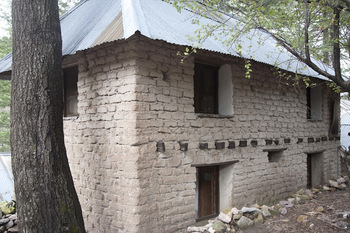 One of the dormitories at Rincón de Guadalupe.The old tin-roofed, mud-adobe structures of Rincón de Guadalupe, perched precariously on a ponderosa- and cedar-forested hillside at about 5,800 feet elevation, have a troubled history. Shortly after the Mexican revolution, those in power decided the Catholic church was personae non gratae, and persecution became institutionalized.
One of the dormitories at Rincón de Guadalupe.The old tin-roofed, mud-adobe structures of Rincón de Guadalupe, perched precariously on a ponderosa- and cedar-forested hillside at about 5,800 feet elevation, have a troubled history. Shortly after the Mexican revolution, those in power decided the Catholic church was personae non gratae, and persecution became institutionalized.
A group of priests and nuns from Hermosillo, in the desert lowlands of Sonora, fled into the Sierra Madre and built a hidden sanctuary—which was discovered by the government and burned to the ground, fortunately when the nuns and priests were absent. After decades of persecution, the church was finally permitted to practice their faith freely, and in 1945, led by the indominable bishop of Sonora, Juan Fortino Navarrete y Guerrero, a group of survivors built the compound that remains today. The church’s property encompasses about 7,000 acres of wild landscape in the Sierra de Bacadéhuachi, most of it unroaded and harboring beautiful Madrean pine-oak forests.
If you’ve ever traveled with a group of dedicated biologists, you know there’s no “okay-camp’s-up-let’s-relax” interlude. Within 15 minutes of our arrival, the entomologists had white sheets up behind UV bulbs to attract flying insects, the herpetologists were out turning over logs and rocks, and the ornithologists were poring through the woods, eyes fixed to their Nikons and Leicas, ears attuned to owl and nightjar calls. Before the first night was out, new range extensions had been set for several species—an astonishing start.
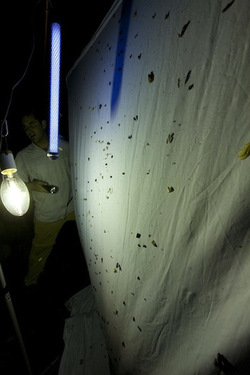 After dinner, I stood before one of John Palting’s sheets for an hour or more, captivated by the thousands of bugs, beetles, and moths clinging to the cloth.
After dinner, I stood before one of John Palting’s sheets for an hour or more, captivated by the thousands of bugs, beetles, and moths clinging to the cloth.
They ranged from tiny drab things a few millimeters long, which John seemed to be able to differentiate at a glance from 10 feet away, to hummingbird-sized monsters patterned like swirled toffee—and one exquisite, scallop-winged, monoplane-like creature that looked like something a miniature Blériot might have piloted across the Channel.
You can get an idea of the task facing the MABA group by glancing at overall numbers for the Sierra Madre Occidental. Within the range’s 900-mile length and 86,000 square miles (the size of Minnesota) you can find 200 species . . . of oak trees. Figure total plant diversity at another 2,500 estimated species or so. Well over half of the 1,000 bird species found in North America can be seen here. Over a hundred species of mammals, a higher-still count of amphibians and reptiles. New species are still being found,  Click to play video of ridge-nosed rattlesnake (Crotalus willardi), courtesy Nico Franz (warning: big file)including several on past MABA expeditions, and species range extensions are commonplace discoveries. Little wonder the group wasted no time getting to work.
Click to play video of ridge-nosed rattlesnake (Crotalus willardi), courtesy Nico Franz (warning: big file)including several on past MABA expeditions, and species range extensions are commonplace discoveries. Little wonder the group wasted no time getting to work.
Over the next three days—a cruelly short window—the group added species after species to the catalog of wildlife and plants in the area. Hard rains had erased all recent spoor, so our mammal tracking efforts recorded the common species leaving fresh sign—white-tailed deer, raccoon, skunk, and coatimundi, a long-tailed relative of the raccoon that roams these parts in large troops.
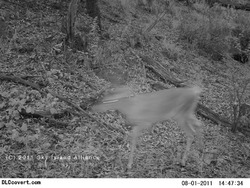 White-tailed deer image from infra-red motion-trigger camera.After studying maps and discussing with our tracking team, which comprised two Sky Island Alliance volunteers and a Sonoran biologist, we placed our single trail camera (one of ours had malfunctioned) at a confluence of two large drainages that we hoped would funnel animals conveniently. Happily, in just two nights the infra-red camera recorded two deer, a grey fox, an Apache fox squirrel, an opossum, and a botanist. And this represented a new range extension for the botanist.
White-tailed deer image from infra-red motion-trigger camera.After studying maps and discussing with our tracking team, which comprised two Sky Island Alliance volunteers and a Sonoran biologist, we placed our single trail camera (one of ours had malfunctioned) at a confluence of two large drainages that we hoped would funnel animals conveniently. Happily, in just two nights the infra-red camera recorded two deer, a grey fox, an Apache fox squirrel, an opossum, and a botanist. And this represented a new range extension for the botanist.
Our pre-trip, map-based projections of the ground we wanted to cover on foot proved to be hilariously optimistic in the precipitous terrain. A full day’s energetic bushwhacking and bouldering down one watercourse and up another probably encompassed three miles of straight-line travel.
We added two canyon tree frogs to the herpetologists’ total for our trouble, and gained a sense of the immensity of the Sierras.
Throughout our stay, the CONANP crew, headed up by the ever-jovial Omar Gutiérrez-Castro and Roberto Torres-García, stuffed us with proper Sonoran food (except for a spaghetti night). Two puppies belonging to the resident caretakers, scrawny and intimidated by the crush of people at first, were by the last night lolling upside down in laps, stomachs the size of bowling balls.
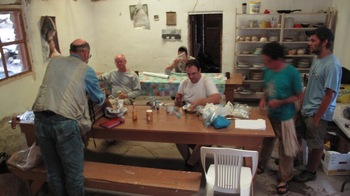 The mess hall was also our library, laboratory, and poker salon.Robert treated us to an extended concert in the tiny, austere chapel—fully as inspiring in its hand-hewn simplicity as the soaring churches. And we got the full story behind Robert’s violin: an 18th-century masterpiece built by a student of the legendary Stradivari—and bestowed to the talented Robert as a gift by an anonymous benefactor who had heard him play a recital in junior high school on a rented Chinese instrument.
The mess hall was also our library, laboratory, and poker salon.Robert treated us to an extended concert in the tiny, austere chapel—fully as inspiring in its hand-hewn simplicity as the soaring churches. And we got the full story behind Robert’s violin: an 18th-century masterpiece built by a student of the legendary Stradivari—and bestowed to the talented Robert as a gift by an anonymous benefactor who had heard him play a recital in junior high school on a rented Chinese instrument.
A heavy rain and hail storm the day before we left presaged interesting conditions on the road down the mountain. We left an hour ahead of the main group, accompanied by Tim Cook with his well-outfitted Jeep, to help clear the trail. As it turned out, the lower reaches had apparently been missed by the storm. We had to pull one downed oak tree out of the road, and add a few rocks to an undercut ravine. But otherwise it was smooth driving for us in the lead, and most of the rest of the group, gravity being on their side this time. But once again luck did not hold for tail-gunner Chris—a Ford pickup that 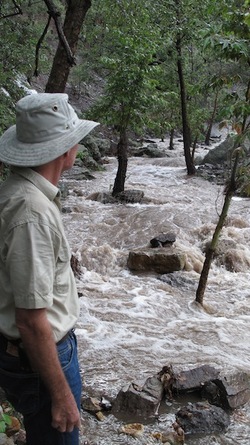 The storm on the next to the last day caused flooding and downed trees, making the journey out a little more exciting.had flattened a tire on the way up destroyed another on the way down, beyond any chance of a repair. A second spare, borrowed from another vehicle, was bolted on, at which point it was discovered the offset firmly grounded the rim against the brake disc. Contacted by radio, we were about to head back up the mountain with the spare from a Ford Explorer that was with us, when Chris called to say they had simply swapped rims front to back and were underway again.
The storm on the next to the last day caused flooding and downed trees, making the journey out a little more exciting.had flattened a tire on the way up destroyed another on the way down, beyond any chance of a repair. A second spare, borrowed from another vehicle, was bolted on, at which point it was discovered the offset firmly grounded the rim against the brake disc. Contacted by radio, we were about to head back up the mountain with the spare from a Ford Explorer that was with us, when Chris called to say they had simply swapped rims front to back and were underway again.
As we waited in the town square in Bacadéhuachi, eating ice-cream popsicles from the little tienda, a group of young biologists garnered intelligence on the whereabouts of a back-yard bacanora still, and wandered off to find it. We pressed them on pain of death to bring back some for hard-working Chris, who had been determined to sample the local product.
In due course the group returned with a hodgepodge of bottles conscripted for the purpose, including one they handed to us. A sniff revealed a potency that promised something in a different universe than even the finest commercial concoction—and when Chris drove up, he insisted on decanting some for us to take home.
Mission accomplished (the biology, not the hooch), our group began to disperse. Tom van Devender, the leader of Sky Island Alliance’s MABA project, headed for Nogales, where the agricultural inspection station would examine his dozens of plant specimens. Another group had just one more spot in the nearby hills they wanted to check. And we, Chris, and two other vehicles headed back north, immediate destination Fronteras, where, on the way south, Roseann had sworn she’d glimpsed a sign reading El Museo del Indio Geronimo. A museum here devoted to Geronimo, the Apache scourge of Mexico? We had to see . . .
# # #
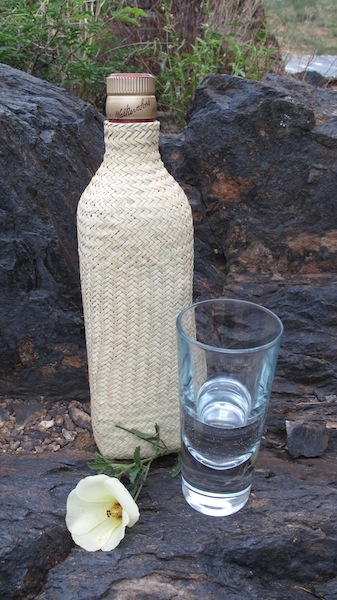 Postscript: At home two nights later, under a violet sunset, Roseann and I broke out that backyard bacanora and filled two shot glasses. First sip—an explosion of raw flavors that seemed to echo the Mother Range that had given birth to it. Heavy smoke from oak fires, earthiness from the roasting pits, the tang of agave heart, and the sinus-clearing bite of alcohol—I didn’t even want to guess at the proof of this stuff. A cautious second sip, then a less-cautious third, simply overlaid the first impressions with yet more power.
Postscript: At home two nights later, under a violet sunset, Roseann and I broke out that backyard bacanora and filled two shot glasses. First sip—an explosion of raw flavors that seemed to echo the Mother Range that had given birth to it. Heavy smoke from oak fires, earthiness from the roasting pits, the tang of agave heart, and the sinus-clearing bite of alcohol—I didn’t even want to guess at the proof of this stuff. A cautious second sip, then a less-cautious third, simply overlaid the first impressions with yet more power.
I took another sip, but this time I held it just behind my tongue, which revealed an astonishing subtlety concealed by the initial jolt. This was no moonshine; there was true craft evident here. The longer I held it, the more complex became the messages it sent. Finally I let it burn pleasurably down my throat.
Did the aftertaste shimmer with just a hint of the strains of a violin sending notes soaring through the nave of a mission church?
Maybe I’d had enough.
Gallery of images, click here
 Click here to download the story in our Terra magazine format, with 16 pages of images, interactive links, and multimedia.
Click here to download the story in our Terra magazine format, with 16 pages of images, interactive links, and multimedia.
Resources
Sky Island Alliance, Madrean Archipelago Biodiversity Assessment, Northern Mexico Program
skyislandalliance.org/maba.htm
A full report of the expedition will be available in September 2011.
MABA Online Database
BICI Mapas, digital and print Mexican topo maps
Comisión de Ecología y Desarrollo del Estado de Sonora
